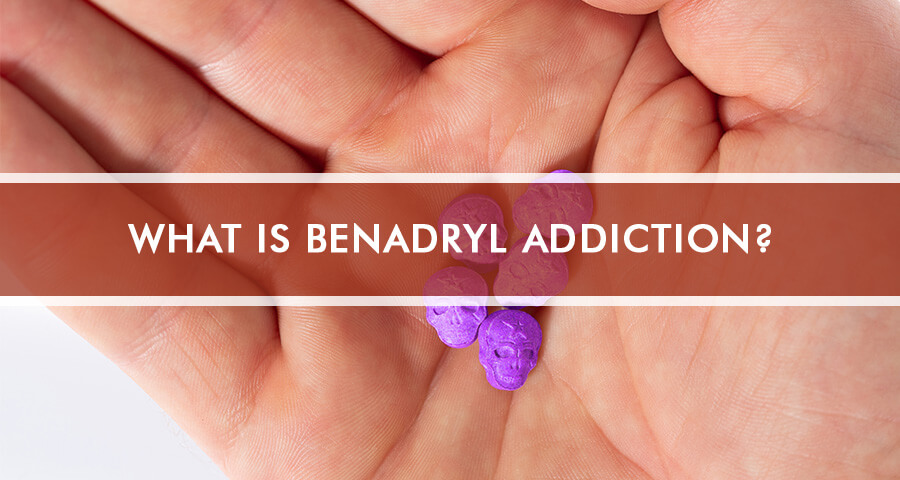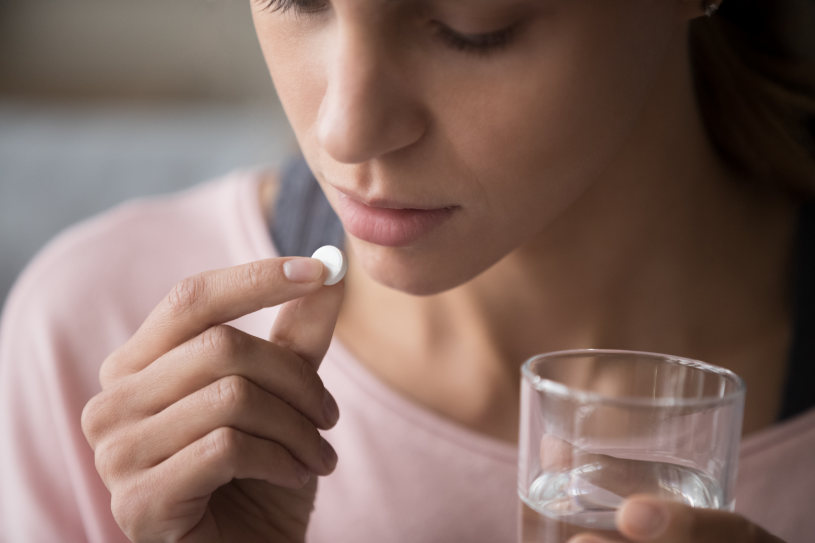
Diphenhydramine(DPH), familiar to most as Benadryl, is an over-the-counter first-generation antihistamine with antimuscarinic properties used primarily for the treatment of seasonal allergies. Its spectrum of use also extends to the treatment of mild insomnia, insect bites, and stings, rashes as well as several other conditions. Despite the broad spectrum of use, there is a long history of Diphenhydramine addiction.
Table Of Contents:
- What is Diphenhydramine?
- What is Benadryl Used for?
- What are the Brand and Generic Names for Benadryl?
- What are Diphenhydramine Formulations?
- Is Benadryl Addictive: Data and Statistics
- What are the risks of Benadryl Abuse and Addiction
- Benadryl Withdrawal
- How to Stop Taking Benadryl Safely?
- Benadryl Addiction Treatment

Throughout the latter half of the 20th century, multiple researchers suggested the potential of Benadryl addiction and some even described case reports of patients who fulfilled the Diagnostic and Statistical Manual of Psychiatry’s criteria for substance abuse. Furthermore, since DPH use is unrestricted and Benadryl abuse is so frequent, being able to recognize signs and symptoms of chronic Diphenhydramine addiction and acute Benadryl withdrawal can be of paramount importance to an individual’s health. Therefore, this article will delve into the most common indications for Diphenhydramine use, the information about its abuse, addiction, withdrawal, and most importantly, the steps to take towards a Benadryl addiction-free life.
It is noteworthy that Benadryl addiction and abuse are well documented in the medical community and warrant discussion.
What Is Benadryl (Diphenhydramine)?
Trade name: Benadryl®
Generic name: Diphenhydramine
Diphenhydramine is a first-generation antihistamine (developed in the 1940s and 1950s) that competes with histamine for binding to H1 receptors. By blocking these receptors, Benadryl prevents histamine from exerting its effects.
Thus, two terms require elucidation in order to truly understand Diphenhydramine. The first is “antihistamine,” and the second is “first-generation.”
Benadryl is commonly used to relieve symptoms such as itching, sneezing, and runny nose due to allergic reactions or the common cold. Due to its short duration of action, it may cause drowsiness, making it suitable for nighttime use.
Antihistamine Effects of DPH
Histamine is a molecule that is found in abundance within our bodies. It is mainly sequestered in mast cells primarily in the skin, the smooth muscle and mucosa of intestinal and respiratory tracts, cardiac muscle, endothelium of blood vessels, and the central nervous system. Within these tissues, histamine plays a significant role in producing symptoms of allergic hypersensitivity through its actions at one of its 5 receptors, referred to as H₁-H₅. Diphenhydramine mediates its action by blocking the action of histamine at H₁ receptors, both in peripheral tissues and in the central nervous system.
The Major Antihistamine Effects of Diphenhydramine Prevents Histamine-Mediated:
- constriction of respiratory smooth muscle
- rapid vasodilation in blood vessels
- increased capillary permeability and subsequent edema
- sensations of itching, pain, and “flare” formation
- increase in heart rate and strength of contraction
DPH a “First-Generation” Antihistamine
The distinction of the first-generation antihistamine is given to various antihistamines. This distinction denotes the capability of some antihistamines, especially Diphenhydramine, to cross the blood-brain barrier and enter the central nervous system(CNS) avidly. Once in the CNS, they can bind to neuronal H₁ receptors and produce drowsiness and sedation as well as suppress medullary cough and vomiting/emesis centers.
Furthermore, it is worth mentioning that DPH acts not only on H₁ receptors but also on Muscarinic Receptors and Sodium Channels, which mediate its “alternative” therapeutic effects.
As these two terms have been elucidated, now the question of “what is Diphenhydramine” can be fully answered. Diphenhydramine is a first-generation H₁ antihistamine medication with concurrent antiemetic, anti-vertigo, and potent sedative/hypnotic properties.

What Is Benadryl Used For?
H₁ receptor blockers are the most commonly used over-the-counter drugs for the treatment of allergic conditions. However, its various effects, as mentioned above, can have other therapeutic potentials.
The Following Is a Brief Overview of the Indications of Its Use:
| For Allergies | The primary indication for over-the-counter Benadryl use is for the treatment of symptoms associated with Allergic Rhinitis(Hay Fever) or other seasonal respiratory allergies:
Severe allergic reactions can be treated by prescription-only injections of Diphenhydramine and are often used as adjuncts in anaphylactic and transfusion-related allergic reactions. |
| For Rash And Itching | It is also frequently used for rash, pruritus, and urticaria associated with contact dermatitis following exposure to substances like poison ivy, oak, or sumac. |
| For Bites | It can also alleviate the swelling, pain, and redness associated with insect bites or stings. |
| For Sleep | Since DPH is a first-generation antihistamine, it readily enters the CNS and causes marked sedation. Due to this effect, it is often offered as a component of various night-time sleep medications for those who suffer from mild insomnia or have difficulty falling asleep due to cold and flu. |
| For Nausea | An alternative version of DPH, Dimenhydrinate, is promoted almost exclusively for the prevention of nausea and vomiting of motion sickness. |
| For Anxiety | No indication exists for the use of DPH for the management of symptoms of anxiety. However, patients with anxiety may inappropriately use it for its ability to elevate mood and increase energy levels, which would constitute Benadryl abuse. |
| For Cough | DPH is part of numerous over-the-counter antitussive or cough medications, due to its ability to suppress the medullary cough centers. |
| For Migraine | While not expressly indicated for this use, some studies have found that the parenteral administration of DPH can assist in alleviating an acute migraine. The medication is used as a type of adjuvant therapy when treating a headache in patients. |
What Are the Brand and Generic Names For Diphenhydramine?
Diphenhydramine Hydrochloride(DPH) is the generic Benadryl. However, Benadryl ingredients in other forms of generic Benadryl can also include Diphenhydramine citrate, Diphenhydramine methylbromide, and Diphenhydramine salicylate.
DPH is available both as over-the-counter and prescription under numerous Generic and Brand Names. Some of these products include:
Over-the-counter Oral Diphenhydramine Preparations:
- 7 Select Allergy
- 7 Select Allergy Children
- 7 Select Night Time Sleep Aid
- Aleryl
- Alledryl
- Banophen
- Basic Care Allergy Relief
- Basic Care Nightime Sleep Aid
- Diphen
- Dibondrin
- Desentol
- Dipheyst
- Dimedrol
- Benadryl
- Benadryl Allergy
- Benylin Cough and Cold
- Circle K antihistamine
- Dormarex 2
- Genahist
- Histaxin
- Hyrexin
- Dermodrin
- Nytol Quickgels
Over-the-counter Topical Diphenhydramine Preparations:
- Sebrx Topical Analgesic
- Rite Aid Maximum Strength Itch Relief
- CVS Maximum Strength Itch Relief
- Select Brand Extra Strength Itch Stopping
- Benadryl Extra Strength Itch Stopping
- Benadryl Itch Stopping Gel
- Itch Relief
- The Itch Eraser
- After Bite Plus
- After Bite Outdoor
- After Bite Xtra
- After Sting
Over-the-Counter Mixture Diphenhydramine Preparations:
- 7 Select Ibuprofen PM
- 7 Select Night Time Severe Cold Cough and Flu
- 7 Select Pain Relief PM
- Acetadryl
- Acetaminophen PM
- Advil PM
- Aleve PM
- Benadryl Severe Allergy & Sinus Headache, Cold
- Theraflu Nighttime Severe Cold & Cough
- Sudafed Sinus Nighttime Plus Pain
- Delsym Cough + Cold Night-Time
- Tylenol PM
- Pain Relief PM Extra Strength
- Contac Day and Night Cold and Flu
- Respa C&C
- Diabetic Tussin Night Time Cold & Flu
What Are Diphenhydramine Formulations?
Diphenhydramine is available in different formulations for children and adults, basically in a gel, lotion, cream, spray, or oral formulations.
Diphenhydramine For Children
Generic and branded formulations are available in the form of a gel, lotion, cream, and spray. The dosage for children depends on their age and weight. It is not recommended to be used for children under the age of 2.
Diphenhydramine Formulations for Kids Include:
- Children’s Benadryl tablets are available in the form of flavored, chewable 12.5 mg tablets.
- Liquid formulation for children is also available, which has 12.5 mg diphenhydramine per 5 ml of the oral solution.
- Topical ointment, lotion, spray, or gel may be used as a topical solution for itching and skin rashes.
Diphenhydramine For Adults
For Adults, Diphenhydramine Oral Formulations Include:
- Benadryl tablets and capsules are available containing 25 mg of diphenhydramine.
- The liquid formulation may be used for flexible dosing according to the doctor’s advice.
- Topical forms are available in the form of ointment, cream, gel, spray, and lotion.
- Diphenhydramine is also available in the form of diphenhydramine HCI Injection, USP.

Is Benadryl Addictive: Data and Statistics
Regardless, systematic studies providing information about the statistics of Diphenhydramine addiction and abuse are lacking, as it is an over-the-counter drug whose sales are not controlled by the FDA. However, some regional studies performed by pharmacists found that 69% of them felt that sedating antihistamines, like Diphenhydramine, were subject to misuse by patients. Based on the aforementioned information, the possibility of Benadryl addiction can be considered as strong.
There Are Various Reasons for Benadryl Abuse:
- Its ease of accessibility as an over-the-counter drug makes it especially susceptible to overuse and abuse.
- Its potent sedative properties, which can be markedly amplified if used concomitantly with alcohol, also increase the likelihood of abuse and subsequent development of Diphenhydramine addiction for those who suffer from insomnia.
- Its short duration of action and propensity for the development of tolerance may lead patients to take increasing dosages of Benadryl at frequent intervals, which would meet the definition of Benadryl addiction.
- One other reason behind Benadryl abuse and addiction may lie behind its ability to elevate mood, and increase energy levels. Its anticholinergic properties may be combined with other drugs and increase dopaminergic neurotransmission in the central nervous system. This may yield rewarding properties and drug-seeking behavior.
What Are The Risks Of Benadryl Abuse and Addiction?
The risk factors behind any substance abuse are commonly shared and include various issues in familial, social, occupational settings as well as previous history of mental health disorders or substance abuse (alcohol, opioids, etc,). With regard to the specific risks of Benadryl abuse and addiction, once again information is lacking. However, one specific group of individuals, namely patients suffering from schizophrenia, were among those who were likely to abuse DPH. This stems from the anticholinergic properties of DPH that can relieve the secondary negative symptoms of antipsychotic drugs.
Signs And Symptoms Of Benadryl Addiction
There are some common signs through which one can identify if someone is addicted to Diphenhydramine. Diphenhydramine is a habit-forming drug that can lead to its dependence.
Some of the Symptoms and Signs of Benadryl Addiction Are Listed Below:
- Unable to fall asleep without taking diphenhydramine
- Feeling anxious and confused when a dose of is skipped
- Agitation and mood swings
- Problems with concentration and focus
- Nightmares and Impatience
- Hallucinations
- Heart palpitations and low blood pressure
- Body jitters and shivering
- Difficulty in urinating
Side Effects Of Diphenhydramine Addiction
Adverse reactions of diphenhydramine addiction include the following physical conditions:
- Short-term memory impairment
- Anxiety
- Irritability
- Nausea
- Blurred vision
- Dizziness
- Constipation
Risks Of Diphenhydramine Overdose
DPH overdose can lead to inevitable severe repercussions to one’s health. According to the study about the dose-dependent toxicity of Diphenhydramine overdose, DPH overdose can lead to acute toxicity. Patients should immediately seek medical help in case of an overdose of Diphenhydramine.
Some of the Signs and Symptoms Associated With Dph Toxicity Include:
- Drowsiness, Reduced Attention, Unsteadiness, Dizziness,
- Dry mouth, blurred vision
- Fast heart-rate
- Muscle twitching, convulsions, headaches
- Confusion, Hallucinations
- Nausea and vomiting
- Urinary retention
Furthermore, it should be noted that consumption of alcohol together with Benadryl can worsen some of the side effects of DPH during an overdose.
To avoid Diphenhydramine HCL withdrawal symptoms, a person should understand how they need to stop using this medicine, especially after they have been using the drug for a more extended period.
Benadryl Withdrawal
When one has developed a dependency on Diphenhydramine or had an overdose recently, a sudden cessation can lead to a more significant severity of symptoms related to withdrawal. When Diphenhydramine withdrawal symptoms develop, the patient may experience a number of adverse health reactions.
Common Benadryl Withdrawal Effects
Each person may experience withdrawal side effects in their own way. For some, withdrawal symptoms may be mild and easy to overcome. Other individuals, however, may find that these symptoms are severe and they could have a significant impact on the person’s daily life and health. The specific withdrawal side effects a person may experience depends on how severe the individual’s addiction is.
Some Possible Side Effects During Diphenhydramine Withdrawal Period That May Occur In a Person Include:
- Difficulty sleeping at night
- Feeling restless and irritable
- Anxiety
- Tremors and muscular aching
- Nausea
- Diarrhea
Some individuals also tend to experience cold sweats while they are withdrawing from the drug. Other people may experience hot sweats instead. This can further contribute to insomnia that the individual is already suffering from due to withdrawal.
It should also be noted that many users may experience symptoms usually associated with a cold while they are going through the withdrawal stage after Benadryl cessation.
These withdrawal symptoms may occur with other types of antihistamines that cause similar side effects as Diphenhydramine as well. Thus, individuals seeking out alternative over-the-counter antihistamines may continue to experience addiction if they give up this drug for another one that can have a similar effect on their bodies.

How To Stop Taking Benadryl Safely?
As noted above Benadryl is prone to the development of withdrawal when doses are missed or stopped abruptly, so it is crucial to consider the half-life of diphenhydramine. Therefore, in those patients wishing to stop Benadryl use, a gradual taper in which the dose of used Benadryl is slowly decreased over a period of time can be used to avoid more significant diphenhydramine withdrawal symptoms.
The environment(Home vs. Rehab) in which cessation of Benadryl use can be carried out depends on the severity of the existent addiction.
- For mild cases of Benadryl addiction, treatment may be carried out at home by gradually decreasing the dosage.
- For severe cases of Benadryl addiction, where a decrease in dosage will result in significant withdrawal symptoms, treatment may need to be carried out in a rehab facility. At the facility, the detoxification from DPH will be carried out using the same form of the gradual decrease in dosage and the patient will be managed symptomatically while recording the severity of withdrawal symptoms on a scale.
Furthermore, if the patient also has concomitant substance use disorder(alcohol, opiates, other prescription medications) or is being treated for other chronic conditions or mental illnesses, a hospital or a rehab setting will be more beneficial in the withdrawal process as the possibility for complications is higher.
Benadryl Addiction Treatment
Benadryl addiction not only affects users physically but emotionally and psychologically as well. Due to the symptoms associated with antihistamine withdrawal, including those individuals who developed a dependency on diphenhydramine, relapse is often possible. Furthermore, patients who are addicted to DPH, often have concomitant addictions to alcohol and other substances. Therefore, seeking professional help at a drug rehab might be an option that patients can consider if they are struggling to overcome their substance abuse disorders. Professional help provided in either an outpatient or inpatient setting can offer the patient a better understanding of their addiction and how they can effectively recover. How long does it take for Benadryl to wear off? It usually depends on how severe the individual’s addiction is. A customized program can be developed for a specific person’s case. During treatment, patients are also offered various therapies to help them regain control over their lives. These may include:
- Psychological therapies,
- Meetings
- Counseling
- Support groups
- Individual and group therapies
After patients have been fully recovered from addiction, they may be required to participate in after-care support programs to ensure that they do not relapse and continue on their road to sobriety.
Hope Without Commitment
Find the best treatment options. Call our free and confidential helpline
Most private insurances accepted
Find Drug Rehabilitation Centers Near You Anywhere In the US
Addiction Resource team has compiled an extensive list of the top drug rehabilitation facilities around the country. Use our locator tool to find the best centers near you.
Page Sources
- American Society of Health-System Pharmacists. (2015, August 15). Diphenhydramine: MedlinePlus Drug Information. Medlineplus.Gov. https://medlineplus.gov/druginfo/meds/a682539.html
- Dicpinigaitis, P. V., Dhar, S., Johnson, A., Gayle, Y., Brew, J., & Caparros-Wanderley, W. (2015). Inhibition of cough reflex sensitivity by diphenhydramine during acute viral respiratory tract infection. International journal of clinical pharmacy, 37(3), 471–474. https://doi.org/10.1007/s11096-015-0081-8
- Brunton, L., Knollmann, B., & Hilal-Dandan, R. (2017). Goodman and Gilman’s The Pharmacological Basis of Therapeutics, 13th Edition (13th ed.). McGraw-Hill Education / Medical
- Halpert, A. G., Olmstead, M. C., & Beninger, R. J. (2001, September). https://www.queensu.ca/psychology/sites/webpublish.queensu.ca.psycwww/files/files/Faculty/Richard%20Beninger/Beninger_prp_25.pdf
- Katzung, B., & Trevor, A. (2020). Basic and Clinical Pharmacology 15e (15th ed.). McGraw-Hill Education / Medical
- Radovanovic, D. (2000, September 19). Dose-dependent toxicity of diphenhydramine overdose. PubMed. https://pubmed.ncbi.nlm.nih.gov/11204550/
- Saran, J. S., Barbano, R. L., Schult, R., Wiegand, T. J., & Selioutski, O. (2017). Chronic diphenhydramine abuse and withdrawal: A diagnostic challenge. Neurology. Clinical practice, 7(5), 439–441. https://doi.org/10.1212/CPJ.0000000000000304
- Thomas, A. (2009, January 23). Diphenhydramine abuse and detoxification: a brief review and case report. PubMed. https://pubmed.ncbi.nlm.nih.gov/18308811/
- Thomas, A., Nallur, D. G., Jones, N., & Deslandes, P. N. (2007). Diphenhydramine abuse and detoxification: a brief review and case report. Citeseerx.Ist.Psu.Edu. https://citeseerx.ist.psu.edu/viewdoc/download?doi=10.1.1.978.5190&rep=rep1&type=pdf
- U.S. NATIONAL LIBRARY OF MEDICINE. (n.d.). BENADRYL- diphenhydramine hydrochloride tablet, film-coated. Dailymed.Nlm.Nih.Gov. Retrieved April 2021, from https://dailymed.nlm.nih.gov/dailymed/drugInfo.cfm?setid=702f9786-7ce9-43e4-921d-e1db09612127&audience=consumer


 Reviewed by:
Reviewed by:  Written by:
Written by: 

 FindTreatment.gov
FindTreatment.gov